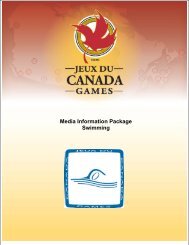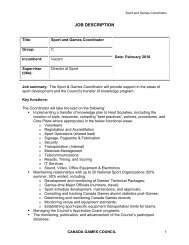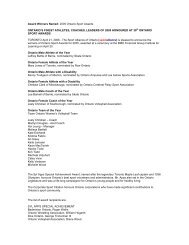Targets for Athlete Performance and the Sport System
Targets for Athlete Performance and the Sport System
Targets for Athlete Performance and the Sport System
You also want an ePaper? Increase the reach of your titles
YUMPU automatically turns print PDFs into web optimized ePapers that Google loves.
training is incorporated into <strong>the</strong> service offering at <strong>the</strong> institutes. The Austrian Ski School <strong>and</strong> <strong>the</strong><br />
<strong>Sport</strong> Etudes program in Quebec are o<strong>the</strong>r examples of innovative partnerships <strong>and</strong> scheduling to<br />
provide athletes <strong>the</strong> opportunity to train <strong>and</strong> complete <strong>the</strong>ir academic training.<br />
In Canada, select support services are delivered to training groups through <strong>the</strong> CSCs, but<br />
Calgary <strong>and</strong> Montreal are <strong>the</strong> only quasi facility-based CSCs that include all <strong>the</strong> elements required<br />
to be internationally competitive with <strong>the</strong> top sporting nations. One of <strong>the</strong> weaknesses with <strong>the</strong><br />
CSC concept is that <strong>the</strong>y were designed to be virtual centres that provide services to athletes, but<br />
not solve <strong>the</strong> more expensive problem of access to quality facilities to train in.<br />
Recommendations: The desired actions <strong>and</strong> outcomes in this area require involvement <strong>and</strong><br />
collaboration from NSOs, PSOs, <strong>the</strong> Canada Games Association, <strong>the</strong> national funding partners,<br />
provincial education ministries, <strong>and</strong> <strong>the</strong> F-P/T partners. Canada needs to create an internationally<br />
competitive network of facility based national <strong>and</strong> regional training institutes that are fully<br />
subsidized <strong>for</strong> priority sports <strong>and</strong> athletes <strong>and</strong> includes <strong>the</strong> following:<br />
• Critical mass of world class athletes<br />
• World class coaching<br />
• World class facilities <strong>and</strong> equipment<br />
• <strong>Sport</strong> science, nutrition, sport psychology, medical <strong>and</strong> alternative health care<br />
support services<br />
• Opportunities <strong>for</strong> domestic <strong>and</strong> international competition<br />
• Residential facilities <strong>and</strong> meal options<br />
• PSO support of development level athlete training groups integration<br />
Fur<strong>the</strong>rmore, <strong>the</strong>re is a need to create a system of sport schools similar to <strong>the</strong> Quebec <strong>Sport</strong><br />
Etudes program in every city with population greater than 50,000. The sport schools will provide<br />
flexible schedules <strong>for</strong> athletes to complete training <strong>and</strong> academics, as well as <strong>the</strong> access to facilities<br />
during non peak hours during <strong>the</strong> day. They can also contribute to <strong>the</strong> fur<strong>the</strong>r development of team<br />
sports by creating a higher level competitive network <strong>for</strong> school-based sports.<br />
5. Competitive Programs with International Exposure<br />
Successful sporting nations have well-structured competitive programmes with ongoing<br />
international exposure. In Canada, athletes with medal potential <strong>and</strong> junior athletes have limited<br />
exposure to important international competition. This is especially <strong>the</strong> case <strong>for</strong> sports that involve<br />
World Cup Circuits or international events that are mostly based in Europe (fencing, volleyball,<br />
alpine skiing, bobsleigh) or in Asia (judo, badminton, taekwondo). Fur<strong>the</strong>rmore, <strong>the</strong> 4-year Canada<br />
Games cycle creates void in domestic competition <strong>for</strong> junior athletes. <strong>Athlete</strong>s may miss <strong>the</strong><br />
opportunity to compete in <strong>the</strong> Canada Games simply because <strong>the</strong>y are not <strong>the</strong> right age, at <strong>the</strong> right<br />
time <strong>for</strong> <strong>the</strong>ir sport. The age limits <strong>for</strong> some sports at <strong>the</strong> Canada Games do not fit with <strong>the</strong> long<br />
term athlete development plan, with <strong>the</strong> result being that athletes that are not part of an NSOs high<br />
per<strong>for</strong>mance development plan participate in <strong>the</strong> Canada Games, while athletes that are part of <strong>the</strong><br />
high per<strong>for</strong>mance plan are excluded. Finally, <strong>the</strong>re is very little opportunity <strong>for</strong> elite domestic<br />
competition <strong>for</strong> many of <strong>the</strong> team sports in Canada especially in <strong>the</strong> post-university age group.<br />
<strong>Athlete</strong> Per<strong>for</strong>mance <strong>and</strong> <strong>Sport</strong> <strong>System</strong> <strong>Targets</strong>, Evaluation, <strong>and</strong> Investment Page 32





